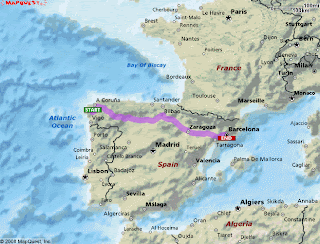
Well, we are in a different environment now.
Barcelona is a lovely European city with lots of hustle and bustle.
Today we did two orientation bus tours and now we have our agenda filled for the next two days.
The weather is hot.
I understand the need for a siesta.
Tonight as I am typing this we have just finished a tapas supper and it was delicious.
Now the evening air is clear and cool...very pleasant. I’ll let Dad do the rest of the message.
Love Mom.”
“City of Barcelona, Comunidad of Cataluña 08 05 20 20:54
Well now we are tourists and by the looks of things just four of many thousands in Barcelona. I think many are here to start Mediterranean cruises as this is a major port city both for container cargo and for cruise liners.
Barcelona is a very international city with an enormously varied architecture both over time and styles. Of course it is the home city of Antonio Gaudi and his Sagrada Familia, a unique cathedral which he began around 1910 and which is still under construction and will be for some decades. He has other buildings in Barcelona as well, all very unique. It is also the home of Salvador Dali and Pablo Picasso so we went to a Dali exhibition yesterday (unplanned, we just found it) but may save Picasso for Madrid.
Barcelona is also a city with a very rich culture, more Mediterranean than Spanish. Today until Friday we are here and then we fly to Sevilla.
Dad”
From Sue Schubert
"Warm, cloudy, rainy and then hot!.
As we hovered over Barcelona, we could see the ripples of the Meditteranean bathing the shores of Barcelona. We have arrived in Catalonia, home of the Catalán language. Lots of different spellings, many x´s used instead of ch or a j sound, etc. You get the picture. The language is used in business and government. But, as usual, all Spaniards must know castellano, or official Spanish, which is what I communicate in. Barcelona is a huge industrial center and busy port and the seat of the Generalitat de Catalunya.
All of our hotels up until now have been centrally located and Barcino 147 is no exception. This is our first B&B and it is quite an experience (to be elaborated on later, maybe). Located on the Gran Via, we walk everywhere. Well, almost. First, we see the city for nearly a full day via Tránsit Barcelona, big red double-decker busses with comprehension dialogue outlining major sights. Want to know where the Museo de la Sagrada Familia is? Right up the hill. The Museo de la historia del pueblo catalán? Down along the waterway. Oh, what is that? Another Gaudí structure? We learn to appreciate and admire him!
Antonio Gaudí (1852-1926) studied architecture in Barcelona. His style was influenced first by Catalán Gothic architecture with its emphasis on large areas of space, and subsequently by the Islamic and Medejár (mixture of Christian and Muslim) style. He also studied nature and animals which inspired his shapes, colors and textures. His most famous and as-yet unfinished monument is the Sagrada Familia (Church of the Holy Family), begun in 1882. Look up; look across; go by elevator to the top and look down. Until present day work continues on this behemouth. Like all of Gaudí´s work, it is organic and out of one´s imagination.
Jean and I visit Parc Guell, an enchanted forest with mushroom-shaped pavilions, a mosaic dragon and a remarkable rolling bench that held more people (tourists) than we cared to look at! We were off for quieter environs, the Monasterio de Pedrables, a monastery (for nuns) started by Queen Elisenda de Montcada in 1327. Huge, peaceful, carefully restored and, the best part, there are still nuns who inhabit the monastery. An enclave from the maddening crowds! Over the next few days, amongst the four of us, we absorb the Museu d´Historia de Catalunya, (a museum that details Catalunya from pre-history to present day); the Joan Miró museum; the waterfront; Las Ramblas where one must stroll at least once to prove he has visited Barcelona; el Mercado Boquerín, an incredibly huge open-air (but covered if that makes any sense) market full of stalls selling the requisite and indigenous fresh, preserved and cured food and, most important, places to eat. You won´t believe this, but Dick and I sat down and ordered, salivating all the while, and who would sit right next to us but a couple from Portland! You know what I am going to say--small world.
Traveling is hard work! We walk and then we walk some more; we bus it; Dick cheats and taxis it. We fall in bed exhausted by night. But not until we have eaten. Two nights we did tapas, the tiny dishes of Spain. Yum. Then Dick and Sue find a fabulous, very small (5 tables) Bistro Bixto of a-tipical tapas. Run by a Dane ex-pat, she is one of the most creative cooks we have ever been exposed to. We returned two nights and we think this says it all.
Where does the time go? Tomorrow we fly south to Sevilla!
"
(NB – The plane likely flew a straighter line then the pink one that appears on the map …. I hope)
 "We are in
"We are in 


